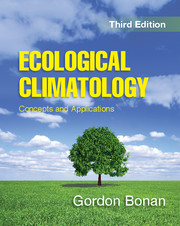Book contents
- Frontmatter
- Dedication
- Contents
- Preface
- 1 Ecosystems and Climate
- Part I The Earth System
- Part II Global Physical Climatology
- Part III Hydrometeorology
- Part IV Biometeorology
- Part V Terrestrial Plant Ecology
- Part VI Terrestrial Forcings and Feedbacks
- 25 Terrestrial Ecosystems and Earth System Models
- 26 Seasonal-to-Interannual Variability
- 27 Biogeophysical Climate–Vegetation Dynamics
- 28 Anthropogenic Land Use and Land-Cover Change
- 29 Carbon Cycle–Climate Feedbacks
- 30 Nitrogen, Chemistry, and Climate
- 31 Aerosols, Chemistry, and Climate
- 32 Urbanization
- 33 Climate Intervention and Geoengineering
- 34 Coevolution of Climate and Life
- Appendix
- Index
- Plate section
- References
27 - Biogeophysical Climate–Vegetation Dynamics
from Part VI - Terrestrial Forcings and Feedbacks
Published online by Cambridge University Press: 05 November 2015
- Frontmatter
- Dedication
- Contents
- Preface
- 1 Ecosystems and Climate
- Part I The Earth System
- Part II Global Physical Climatology
- Part III Hydrometeorology
- Part IV Biometeorology
- Part V Terrestrial Plant Ecology
- Part VI Terrestrial Forcings and Feedbacks
- 25 Terrestrial Ecosystems and Earth System Models
- 26 Seasonal-to-Interannual Variability
- 27 Biogeophysical Climate–Vegetation Dynamics
- 28 Anthropogenic Land Use and Land-Cover Change
- 29 Carbon Cycle–Climate Feedbacks
- 30 Nitrogen, Chemistry, and Climate
- 31 Aerosols, Chemistry, and Climate
- 32 Urbanization
- 33 Climate Intervention and Geoengineering
- 34 Coevolution of Climate and Life
- Appendix
- Index
- Plate section
- References
Summary
Chapter Summary
This chapter examines the biogeophysical coupling between terrestrial vegetation and climate. Daisyworld is first introduced as a simple model of coupled climate–vegetation dynamics. The Daisyworld model illustrates the potential for regulation of climate by vegetation. More realistic examples of climate–vegetation interactions occur regionally in response to gradients in precipitation or temperature. The gradient from tropical rainforest to tropical deciduous forest to savanna to desert represents increasing aridity. This gradient is not only a response to soil moisture but also feeds back to affect climate, especially precipitation. An example of this is in northern and western Africa, where climate model simulations demonstrate that the expansion of vegetation into desert in response to increased rainfall feeds back to increase rainfall. Another example is the boreal forest–tundra ecotone. The transition from forest to tundra relates to cold temperature. Numerous studies show that the northward migration of trees in response to climate warming feeds back to accentuate the warming; loss of tree cover with a cold climate reinforces cold temperatures. These studies indicate widespread changes in vegetation structure and biogeography in response to climate change are likely to themselves change climate. Carbon cycle feedbacks are considered in Chapter 29.
Biogeophysical Feedbacks
The studies outlined in Chapter 26 highlight biogeophysical processes by which Earth's land and its vegetation affect seasonal-to-interannual climate variability. Changes in vegetation structure, composition, and biogeography in response to long-term climate change similarly feed back to influence climate change. This arises from differences among vegetation in albedo, surface roughness, leaf area index, rooting depth, and canopy conductance.
The albedo of land varies with surface characteristics (Table 12.1). Vegetation generally has a lower albedo than bare soil; forests have a lower albedo than pastures or croplands. As a result, changes in vegetation such as grassland degradation or expansion and forest loss or woody encroachment alter surface albedo. An increase in surface albedo decreases net radiation at the land surface and reduces heating of the atmospheric boundary layer as well as water vapor in the boundary layer. A positive feedback develops if these changes decrease precipitation because drier soil directly increases albedo and further reduces vegetation cover (Figure 27.1a).
- Type
- Chapter
- Information
- Ecological ClimatologyConcepts and Applications, pp. 500 - 522Publisher: Cambridge University PressPrint publication year: 2015



